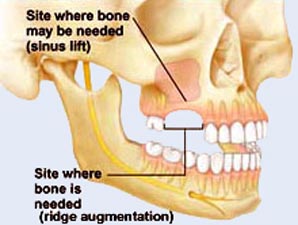A sinus lift, also known as augmentation of the sinuses, is a surgical procedure used to add bone to the maxilla, or upper jaw in order to ensure sufficient support for dental implants. The surgery is performed by an oral and maxillofacial surgeon approximately six to nine months before placement of the implants.
The Sinus Lift Process
Depending on the extent of the procedure and the amount of bone material needed it may be synthetic or harvested from the patient.
The surgeon takes multiple x-rays of the area in order to fully examine the interior of the sinus as well as the structure of the jaw itself.
After anesthesia has been administered to ensure patient comfort, a small incision is made in the gum tissue in the space left by the missing tooth or teeth.
When the jaw is exposed, the surgeon makes a cut in the bone and presses it up into the sinus cavity along with a portion of the sinus membrane. The resulting space is filled with either the harvested bone or the synthetic material.
The grafted material is left to grow with your natural bone to create a reinforced area capable of accepting and supporting an implant.
Why Would I Need a Sinus Lift?
The maxilla tends to have slightly less natural bone material than the mandible in general. A number of factors may be responsible for the need of a sinus lift before implants can be placed. The most common include:
- Periodontal Disease – Advanced disease of the gums leads to a number of serious problems, including loss of bone beneath the teeth and gum tissue. The remaining bone may not be sufficient for a dental implant procedure.
- Loss of Teeth – When a tooth is lost or is extracted, the jawbone beneath the missing tooth may begin to deteriorate, thus necessitating a sinus lift before implants are a viable option.
- Anatomy – The anatomy of the oral cavity, jaw and sinuses has been shown to vary between individuals and to change with age. If the maxillary sinus is situated in such a way as to prevent the placement of implants, it may be possible to remedy the problem with a sinus lift procedure.
After the Surgery
Some minor swelling may be present at and around the surgical site immediately after the procedure but should subside relatively soon. Avoid actions that may cause the stitches to become loose and behaviors that may dislodge the graft, including blowing your nose and brushing your teeth vigorously.
Your surgeon will provide you with additional information on how to take care of your incision until it is completely healed as well as medication to reduce pain and to reduce the risk of infection. You will also be given a special mouthwash to use daily. After approximately one week, you will return to your surgeon’s office for a follow-up visit.
Future visits may be necessary to ensure that the surgical site is healing properly and that the bone material is being accepted by your jaw and hardening as it should.
In most cases, sinus lift patients are free of pain and swelling by the time they see their surgeon for the first post-operative checkup.
Shanna Cramer contributes to blogs on oral surgery, cosmetic surgery, graphic design and web design.





